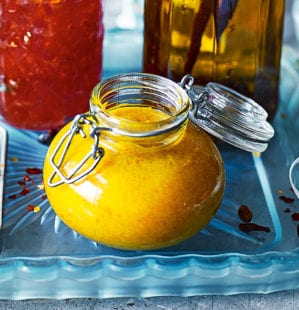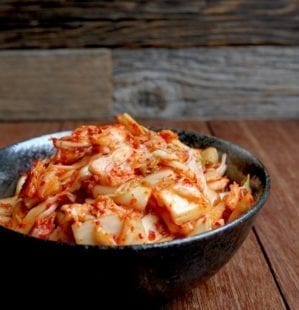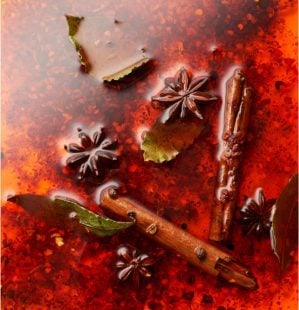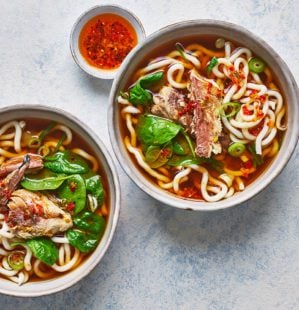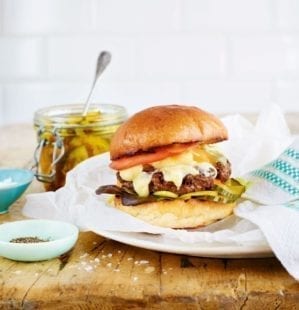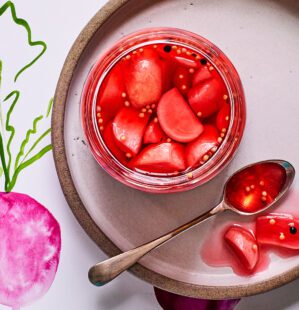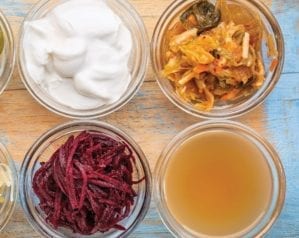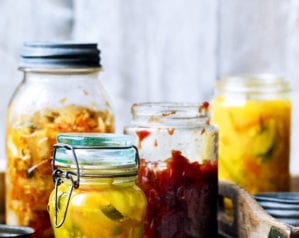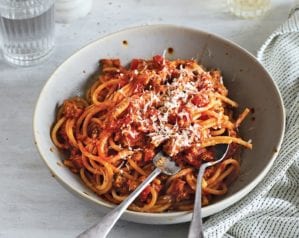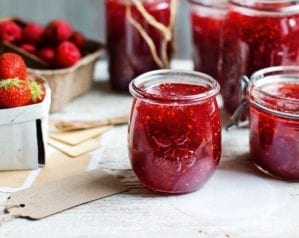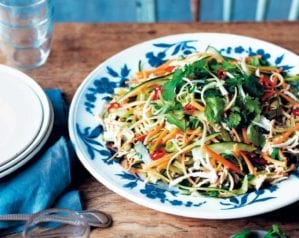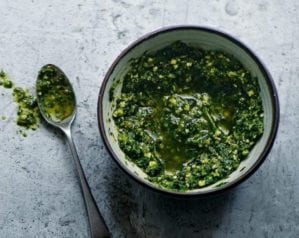
Fermented hot sauce
- Published: 2 May 24
- Updated: 20 Nov 24
Far more complex in flavour than its vinegar-based cousins, James Read’s fermented hot sauce is one of the easiest ways to venture down the rabbit hole of home fermentation. All you need to get started is a clean jar, chillies, salt and some patience – before you know it you’ll be filling your shelves with gently fizzing jars of fiery goodness. See Know-how below for ideas on how to jazz up this base recipe, too.
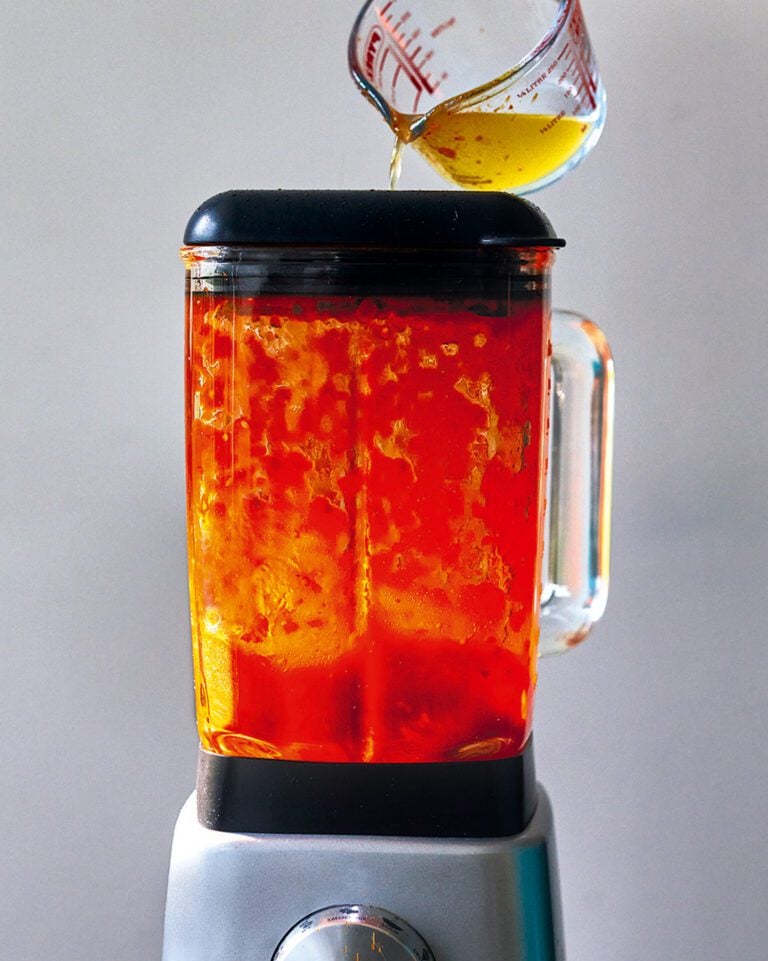
Once you’ve mastered this recipe, have a bash at making kimchi.
As well as running his Kim Kong Kimchi brand, James Read is a London-based journalist. This recipe taken from his much-praised book Of Cabbages & Kimchi: A Practical Guide To The World Of Fermented Food (Particular Books £22) and tested by delicious.
-
Makes about 300ml, depending on how much you dilute it
-
Hands-on time 10 min, plus at least 3 weeks fermenting
Before you start
Please wear gloves. When working with lots of chillies, it’s almost impossible to avoid getting capsaicin particles in unwanted places. If you’re without gloves, rub your hands with oil before soaping them (oil-soluble capsaicin dissolves more easily this way, then you can wash it all off).
See our guide to sterilising jars.
Ingredients
- 150g chillies
- 9g salt
Specialist kit
- 1 sterilised 300ml jar
- 1 (optional) sterilised 300ml bottle
Method
- Wearing gloves, remove the stems and chop the chillies into wide slices, then pack as tightly as possible into a sterilised jar.
- Mix the salt with 250ml lukewarm water and stir until dissolved. Pour over the chillies until just covered (you probably won’t need all the brine). Push down any chillies that try to float – a small (sterilised) weight to put on top to keep the chillies submerged is helpful here.
- Seal the jar and leave it on a work surface out of the sun, checking once a day for fizz. When it begins, open the jar once a day to let any gas escape. Once the mixture starts fizzing, the brine will cloud over, then a few days later the fizzing will stop, but it’s still fermenting. The longer you leave it, the better the sauce will be, but aim for a minimum of 3 weeks and 12 or more if you really want to age it. Taste (gingerly!) to check if it’s ready – you’re looking for a sour, vinegary flavour.
- Pour off and reserve the brine, then whizz the chillies to a paste in a blender, returning as much brine as you like for your desired consistency (strain through a fine sieve if you want it smooth). Return to the jar or transfer to a sterilised bottle and chill – it will keep for several months.
- Recipe from May 2024 Issue
Nutrition
- Calories
- 2kcals
- Fat
- 0g
- Protein
- 0g
- Carbohydrates
- 0.5g (0.5g sugars)
- Fibre
- 0g
- Salt
- 0.5g
delicious. tips
TROUBLESHOOTING
If your hot sauce is…• Not fermenting
Chillies can be slow to get going, especially in a high-salt environment. If they take more than a couple of weeks, you may have to start again – although if there’s no sign of mould, you may as well leave your problem-batch running. Make sure the amount of salt is correct and try fermenting somewhere warmer.• Forming a white film while fermenting
This is probably kahm yeast, which can be a problem with longer ferments, especially if there’s a lot of sugar (for instance if you’ve added peach or
mango; see Know-how). It’s unlikely to be harmful, but can affect flavour slightly. Remove the film and continue fermenting. In hot weather, you may need to increase the brine to 5% (12.5g salt to 250ml water) to counteract this.• Forming a white film once bottled
This is rarer, but it’s still likely to be kahm yeast. Add some vinegar (1 tbsp per 150ml should do).• Too spicy
There’s not a lot you can do, except make it again with milder chillies. Mixing it with mayonnaise will subdue the heat. Or give it away – I’m always happy to receive a bottle of hot sauce.A few of James’ favourite blends
“The range of chillies, fruit and spices you can use while following the same basic steps of making hot sauce means you absolutely ought to experiment with different ingredients. I’ve adjusted the salt in each of these versions to account for extra ingredients.”• Bird’s eye and peach
Follow the base recipe, substituting the chillies with 150g bird’s eye chillies (roughly chopped) and 1 peach, peeled and roughly chopped. Add the peach to the jar, wedging in the pieces to stop them floating, followed by the chillies and brine, upping the salt to 12g.• Red habanero, pepper and onion
Follow the base recipe, swapping the chillies for 60g (4-6) red habaneros, ½ red pepper, deseeded, and ½ onion, all roughly chopped. Add the chillies,
pepper, onion and brine (with 11g salt) to the jar.• Mango, orange scotch bonnet and ginger
Follow the base recipe, swapping the chillies for 60g (4-6) orange scotch
bonnets, the flesh of ½ mango, a 1cm piece of peeled ginger and ½ onion, all roughly chopped. Add the ginger to the jar, then the mango, onion, chillies and brine, with 11g salt.• Scotch bonnet, mustard and turmeric (Bajan)
Follow the base recipe, swapping the chillies for 60g (4-6) orange scotch
bonnets, 50g fresh peeled turmeric and ½ onion, all roughly chopped. Add 1 tsp yellow mustard seeds to the jar, then the turmeric, onion, chillies and brine, with 11g salt. The turmeric amplifies the scotch bonnet flavour, making it even fruitier.• Pineapple and garlic
Follow the base recipe, substituting the chillies with 300g ripe pineapple,
20g garlic and 75g red habaneros, deseeded, all roughly chopped. Add the brine, increasing the salt to 15g. Use a 500ml jar.
Buy ingredients online
Rate & review
Rate
Reviews
Subscribe to our magazine
Food stories, skills and tested recipes, straight to your door... Enjoy 5 issues for just £5 with our special introductory offer.
Subscribe
Unleash your inner chef
Looking for inspiration? Receive the latest recipes with our newsletter

